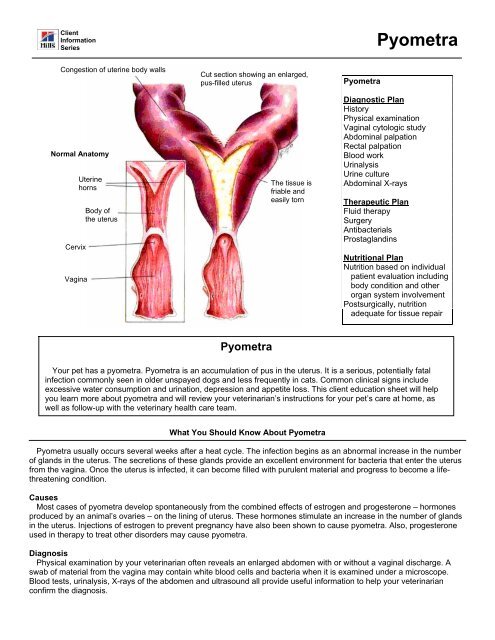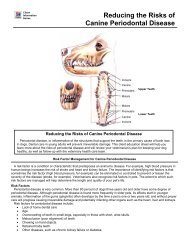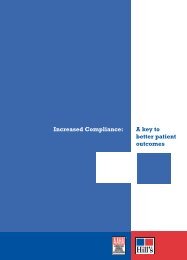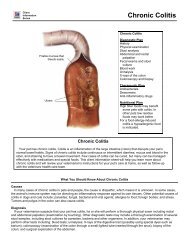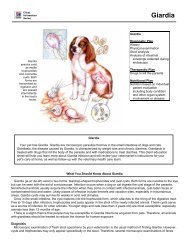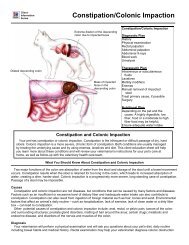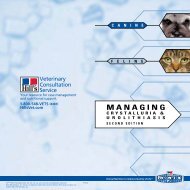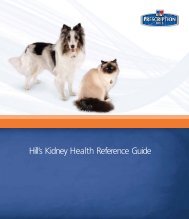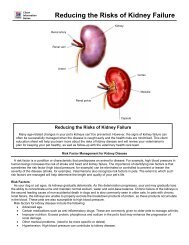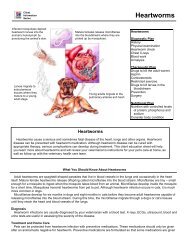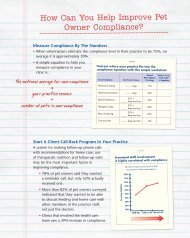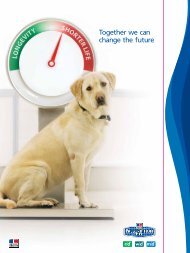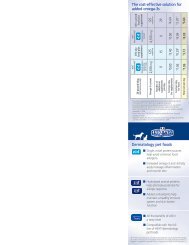Pyometra - HillsVet
Pyometra - HillsVet
Pyometra - HillsVet
Create successful ePaper yourself
Turn your PDF publications into a flip-book with our unique Google optimized e-Paper software.
Client<br />
Information<br />
Series<br />
<strong>Pyometra</strong><br />
Congestion of uterine body walls<br />
Normal Anatomy<br />
Cervix<br />
Vagina<br />
Uterine<br />
horns<br />
Body of<br />
the uterus<br />
Cut section showing an enlarged,<br />
pus-filled uterus<br />
The tissue is<br />
friable and<br />
easily torn<br />
<strong>Pyometra</strong><br />
Diagnostic Plan<br />
History<br />
Physical examination<br />
Vaginal cytologic study<br />
Abdominal palpation<br />
Rectal palpation<br />
Blood work<br />
Urinalysis<br />
Urine culture<br />
Abdominal X-rays<br />
Therapeutic Plan<br />
Fluid therapy<br />
Surgery<br />
Antibacterials<br />
Prostaglandins<br />
Nutritional Plan<br />
Nutrition based on individual<br />
patient evaluation including<br />
body condition and other<br />
organ system involvement<br />
Postsurgically, nutrition<br />
adequate for tissue repair<br />
<strong>Pyometra</strong><br />
Your pet has a pyometra. <strong>Pyometra</strong> is an accumulation of pus in the uterus. It is a serious, potentially fatal<br />
infection commonly seen in older unspayed dogs and less frequently in cats. Common clinical signs include<br />
excessive water consumption and urination, depression and appetite loss. This client education sheet will help<br />
you learn more about pyometra and will review your veterinarian’s instructions for your pet’s care at home, as<br />
well as follow-up with the veterinary health care team.<br />
What You Should Know About <strong>Pyometra</strong><br />
<strong>Pyometra</strong> usually occurs several weeks after a heat cycle. The infection begins as an abnormal increase in the number<br />
of glands in the uterus. The secretions of these glands provide an excellent environment for bacteria that enter the uterus<br />
from the vagina. Once the uterus is infected, it can become filled with purulent material and progress to become a lifethreatening<br />
condition.<br />
Causes<br />
Most cases of pyometra develop spontaneously from the combined effects of estrogen and progesterone – hormones<br />
produced by an animal’s ovaries – on the lining of uterus. These hormones stimulate an increase in the number of glands<br />
in the uterus. Injections of estrogen to prevent pregnancy have also been shown to cause pyometra. Also, progesterone<br />
used in therapy to treat other disorders may cause pyometra.<br />
Diagnosis<br />
Physical examination by your veterinarian often reveals an enlarged abdomen with or without a vaginal discharge. A<br />
swab of material from the vagina may contain white blood cells and bacteria when it is examined under a microscope.<br />
Blood tests, urinalysis, X-rays of the abdomen and ultrasound all provide useful information to help your veterinarian<br />
confirm the diagnosis.
Treatment and Home Care<br />
Surgical removal of the ovaries and uterus (ovariohysterectomy) is the recommended treatment. Supportive therapy<br />
before, during and after surgery is critical. Most patients with pyometra are very ill and require fluid therapy to help support<br />
kidney function. Antibiotics are given as well.<br />
Antibiotics and drugs called prostaglandins are sometimes used to treat mildly affected dogs whose owners want to use<br />
them for breeding. This therapy is not recommended for most animals because of the potential severity of pyometra and<br />
because pyometra may recur in medically treated animals.<br />
Home care consists of giving medications as prescribed and monitoring your pet’s appetite and water consumption. If<br />
your pet is depressed and refuses to eat, call your veterinarian. Excessive water consumption and urination should<br />
gradually decrease to normal.<br />
Check your pet’s incision at least once a day. If the incision is red and swollen, oozes blood, or begins to separate, call<br />
your veterinarian. Exercise should be limited to leash-walking for the first week after surgery. You may need to return to<br />
your veterinarian’s office for suture removal and lab rechecks.<br />
Nutritional Plan<br />
<strong>Pyometra</strong> usually occurs in older animals and causes severe illness and impaired liver and kidney function. Even<br />
though your pet may recover from pyometra in a week or two, the lesions in the kidneys may take months to heal.<br />
Because of this, your veterinarian may give you special feeding instructions. Patients with renal failure often benefit from<br />
foods with reduced amounts of phosphorus, sodium and protein. These special foods help prevent an accumulation of<br />
waste materials in the blood and will reduce the workload on the kidneys.<br />
Foods such as Hill’s® Prescription Diet® k/d® Canine and k/d® Feline Renal Health are formulated by veterinary<br />
nutritionists to reduce the demands on impaired kidneys. These foods contain high-quality protein, but in smaller amounts<br />
than in most pet foods, so the kidneys have less waste materials to eliminate. Because excess phosphorus can contribute<br />
to kidney disease, phosphorus is also reduced in these foods. Also, the reduced dietary sodium in these foods has been<br />
shown to maintain normal blood pressure. High blood pressure frequently occurs with kidney failure.<br />
Transitioning Food<br />
Unless recommended otherwise by your veterinarian, gradually introduce any new food over a seven-day period. Mix<br />
the new food with your pet’s former food, gradually increasing its proportion until only the new food is fed.<br />
If your pet is one of the few that doesn’t readily accept a new food, try warming the canned food to body temperature,<br />
hand feeding for the first few days, or mixing the dry food with warm water (wait ten minutes before serving). Feed only<br />
the recommended food. Be patient but firm with your pet. This is important because the success or failure of treatment<br />
depends to a large degree on strict adherence to the new food.<br />
Presented as an educational service by<br />
Client’s Name:<br />
Patient’s Name:<br />
Medication(s):<br />
Home Care Instructions<br />
_________________________________________________________<br />
_________________________________________________________<br />
_________________________________________________________<br />
Nutritional Recommendation: ___________________________________________________<br />
Follow-Up Appointment: _______________________________________________________<br />
(Hospital Stamp Area Above)<br />
REGULAR VISITS WILL HELP OUR VETERINARY HEALTH CARE TEAM PROVIDE FOR YOUR PET’S BEST INTEREST.<br />
©2011 Hill’s Pet Nutrition, Inc.<br />
®/ Trademarks owned by Hill’s Pet Nutrition, Inc.


